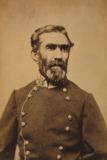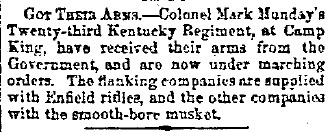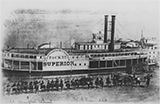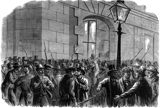
![]()
Except for some serious fighting in Augusta, there were no great Civil War Battles in Northern Kentucky. The Confederacy sent some troops north to see how Cincinnati was
defended, and it was defended very well with the forts noted below.
There were skirmishes up and down what is now the Dixie Highway, but
no battles. The generals involved at the time are these men: (Links are to Wikipedia) |
||||
| The Confederate Generals | The Union Generals | |||
Braxton Bragg |
 |
Don Carlos Buell Headed up Union Troops in Kentucky |
||
| Edmund Kirby Smith reported to Bragg, sorta |
 |
 |
Horatio Wright Headed up Union Troops in Ohio |
|
| Henry Heth reported to Smith, and tentatively moved into Northern Kentucky, but finding it guarded, withdrew. Last in his class at West Point. |
 |
Lew Wallace was appointed by Wright to defend Northern Kentucky and Cincinnati. He did. |
||
| You can read a piece on Bragg's efforts in Kentucky, in 1862 (when troops would be in
Augusta, Walton, and Crittenden, by Basil Duke, here. (pdf)
Bragg and Buell would eventually clash at Perryville, in the bloodiest battle in Kentucky(and what one historian called “simply a useless slaughter, without special advantage to either side.”) Read about it at this site: the Battle of Perryville. |
||||
| “President Lincoln, in a conversation in Washington city with Hon. Garret Davis, of Paris, Ky., states distinctly that he would make no military movement upon any state or section that did not offer armed resistance to the authorities of the United States, or the execution of the laws of Congress; that he contemplated no military operations that would require him to march troops into or across Kentucky, and therefore he should not attempt it; that if Kentucky, or her people, should seize upon the U. S. post at Newport, it would be his duty, and he might attempt, to retake it; that it was the duty of Kentucky to have furnished the quota of troops for which he made the requisition on her, but that he had neither power, not right of disposition to coerce her; and if she made no war upon her own government of the United States, it would make no war upon her.” from The History of Kentucky, by the Late Lewis Collins, Judge of the Mason County Court, Revised, Enlarged Four-Fold, and Brought Down to the Year 1874 by His Son, Richard H. Collins, A.M., LL.B. |
![]()
We like this short film from Cam Miller about the Civil War in Northern Kentucky
![]()
| Camp King and Coles Garden were the same place. Coles Garden was an amusement park/beer garden located between James Avenue and the Licking River in Covington. During the Civil War, it was converted into a fort. It reverted back to Coles Garden after the war. We've rounded up several newspaper articles about both. | ||
| Camp King commenced at Cole's Garden | ||
| Cole's Garden, 1861 | Camp King Aid, November | |
| Coles Garden, 1862 | Camp King Aid, December | |
| Coles Garden, 1866 | Camp King. The bill. | |
|
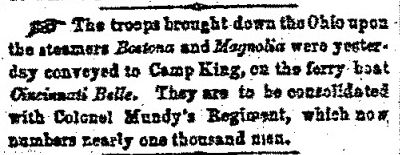 Cincinnati Daily Enquirer, December 14, 1861 |
|
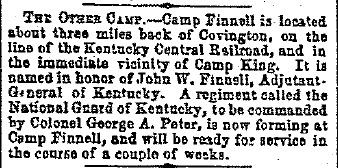 Cincinnati Daily Enquirer, November 3, 1861 |
“The soldiers at [Camp King] desire to acknowledge the receipt of a wagon load of chickens, turkeys, mutton, beef, and pork roasts, ham, fruits, pies, preserves, jellies &c., &c., from the ladies of Crittenden, Grant county, sent for Christmas day.” Cincinnati Daily Commercial, December 27, 1862 | |
The Superior
“Three companies of the Ohio 20th, at Camp King, left on the steamer Superior for Warsaw, Ky., yesterday.”
Cincinnati Daily Commercial, December 27, 1862
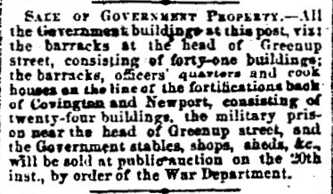
Cincinnati Daily Enquirer, December 14, 1865
![]()
Northern Kentucky Civil War Defense Fortifications
You can locate the forts and batteries above on the three maps below.
 |
  |
| You know Fort Wright and Fort Mitchel,
but can you place Northern Kentucky's Fort Rich? Fort Perry? |
"Map showing the military defenses of Cincinnati, Covington and Newport Constructed under the direction of Brig. O. M. Mitchell, by Col. Charles Whittlesey in 1861: repaired and extended under the direction of Major Genl. H. G. Wright commanding Department of the Ohio, by Maj. J. H. Simpson, Chief Topogl. Engr. of the Dept. Bvt. Capt. W. E. Merrill, & Lieut. J. A. Tardy, Corps of Engs., and Col. Chas. Whittlesey, in 1862. Complied by order of Maj. Genl. H. G. Wright commanding Department of the Ohio, chiefly from surveys made under the direction of Maj. J. H. Simpson by W. H. Searles, G. A. Aschbach, O. P. Ransom, and J. R. Gillis, in Septr. & Octr. 1862. Published by authority of the Hon. the Sec. of War, in the office of the Chief of Engineers, U.S. Army." |
| Thanks to Jeannine Kreinbrink for sending us this chart (pdf) she compiled about all the forts, their style, and who they were named for. | |
| Guerillas at Shaler Battery. | |
| Here is a site with contemporary pictures of the Civil War Forts. |
We've made a stab at doing an overlay of the Whittlesey 1861 Civil War map above, with a contemporary map of Northern Kentucky. We're not sure if it's enlightening or confusing, but here it is; two maps in one. |
![]()
Joel Shutt wrote a thesis (pdf) on Confederate Sympathy in Northern Kentucky
| In 1867, The Freedmens' Bureau (Natinal Archives) issued a report of some of the atrocities committed after the Civil War. The Cincinnati Daily Gazette published a summary of an early Kentucky report. Their state summary is here. We've excerpted the parts from Northern Kentucky here. Neither is for the squeamish. |
In 1868, a reporter from a Cincinnati newspaper toured Northern Kentucky to get citizens’ views on the upcoming elections. Civil War and Reconstruction feelings were still running strong, and he gets an earful. We think it's fascinating. You can read it here, but if politically incorrect language upsets you, you should pass. |
![]()
Cincinnati's famous Black Brigade and their help building fortifications in Northern Kentucky are detailed by Steve Preston at this site. |
![]()
| “January 10, 1866 - Gen. Henry Heth, late of the Confederate States army, while on a visit to Cincinnati, examines the earthworks thrown up in the rear of the cities of Covington and Newport, in Sept., 1862, to check the progress of his army. He said he was constantly advised to the accessions of the U. S. forces, and their exact situation, and was abundantly able to capture the three cities. The Cincinnati Commercial reports him as saying that ‘he was fully aware of the absence of veterans, and knew when [Union] Gen. Granger came in with his regiment from Corinth. He telegraphed to Gen. Kirby Smith, at Lexington, that he could take Cincinnati with the loss of perhaps a hundred men, and asked for instructions. General Smith's reply ordered him to take the city. He promptly prepared to mass his forces and break the greatly extended and imperfect Federal lines - fixing the time and place to do so. But a second telegraph from Gen. Smith informed him that Gen. Buell's movements made it necessary for Gen. Bragg to concentrate his whole army; that a division could not be spared, even to hold Cincinnati; and after Buell was whipped in Kentucky, the cities on the Ohio river would fall into their hands without further fighting. This compelled a countermand of the order to advance upon the Federal entrenchments, and the Confederate troops moved off rapidly to the center of Kentucky.’” from The History of Kentucky, by the Late Lewis Collins, Judge of the Mason County Court, Revised, Enlarged Four-Fold, and Brought Down to the Year 1874 by His Son, Richard H. Collins, A.M., LL.B. |
|
| “Sometime in '63 (1863) we had a new preacher come to East Bend. He was an attractive man - but somewhat jumpy and nervous. He preached good sermons and led the singing in fine style but he was a little unreliable in his quotations from the Bible. He stayed at Uncle William's who at this time was living in grandfather's house which had been built near Rising Sun. One morning Aunt Mary called Mr. Phelps to breakfast and when he didn't appear she went to his room, thinking he must be ill. She found the window open - an empty pistol case on the bureau - and no Mr. Phelps. It developed that our young peachier was a confederate spy and had been passing information through the lines all summer. We never heard of him again, but wondered about his fate many times.” from http://www.bottorff.org/Piatt.htm |
| “July 9, 1863 - The archives of Ky., about four wagon loads in all, sent from Frankfort to Covington for safekeeping.” from The History of Kentucky, by the Late Lewis Collins |
| Orders issued prohibiting the exportation of hogs out of the state of Kentucky. Disgruntlements ensue. from The History of Kentucky, by the Late Lewis Collins |
| We highly recommend Roger Adams' paper, Panic on the Ohio (pdf) on Heth's approach and withdrawal from Northern Kentucky/Cincinnati, |
![]()
| “The Confederate raid into Kentucky--excitement at Covington--gathering of armed Federal citizens at the railroad and telegraph office, on hearing of the capture of Cynthiana by the Confederate Morgan. The dash of Morgan from his mountain haunts in Tennessee through Kentucky caused considerable alarm throughout the State, for it was well planned and boldly executed. It is said to have been an inspiration from Jeff Davis himself, intended to produce a general uprising in Kentucky against the Federal Government. The people, however, soon recovered from their momentary terror; and it was then seen how much stronger the Federal sentiment was in Kentucky than that of Secession.” —Leslie, 1896 |
From the top, those are men signing up in Cincinnati to resist the approaching Confederates, the pre-pontoon bridge bottleneck, and a position being created somewhere in Northern Kentucky. from Harpers Weekly, September 9, 1862. H. Mosler was the illustrator. |
 |
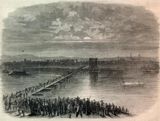 |
 |
| Federal volunteers crossing the Ohio River from Cincinnati to Covington on a pontoon bridge of coal barges on September 5th, 1862 to defend Cincinnati against advancing Confederate troops. That’s a partially completed pier of the Suspension Bridge in the background. | ||
“It should be understood that the pontoon bridge across the river is only eligible to the military. The guards are continually annoyed by the application of civilians and ladies who are anxious to cross merely, we should imagine, for the novelty of the thing.” Cincinnati Enquirer, September 10, 1862 |
||
| A soldier, William Wiley, wrote in his diary about the process of getting the mule-drawn wagons across the pontoon bridge. Read the excerpt from his diary. | ||
Wesley Cameron is the man that actually designed and built the pontoon bridge. In 48 hours.
![]()
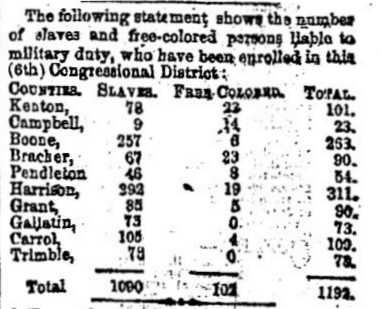
Cincinnati Enquirer, April 9, 1864
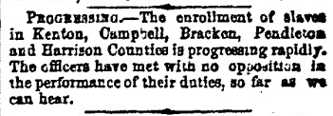
Cincinnati Enquirer, October 28, 1862

Cincinnati Commercial Gazette, February 19, 1884
| Confederate hero John Hunt Morgan escaped his imprisonment in Columbus Ohio, came south to Cincinnati, crossed the river into Ludlow, wound through Boone County to Napoleon in Gallatin County, and then through Owen County. You can read more details on his route here, (pdf) and here. | “From general observation, when we consider the natural feeling of a white man that is born and reared in the State of Ohio, regarding the rights and privileges due our race, especially if he is engaged in business in Kentucky, or an employee, his greatest aim is to stir animosity and impede the Negro. But the Kentuckian will assist the Negro, and you can find him what he professes to be. A hint should be sufficient.” from Indianapolis' The Freeman, A National Illustrated Colored Newspaper, August 9, 1890 | Appomattox may have officially ended the conflict, but hardly the hostilities. Ghent's Bill Davis sent us this reference to a Gallatin/Carroll County post-Civil War episode that ended up in the U.S. Supreme Court. Details at this site. That site will give you a summary, and for all the gory details, follow the link at the top of that page. Fascinating stuff. |
| This article talks about seeing General John Hunt Morgan in Sandfordtown. Unlikely. | This article talks about Morgan's men - not Morgan - in Owen and Gallatin. | Prisoners, brought to Newport Barracks. |
| “The Maysville, Kentucky, Eagle, asks the following very suggestive and pertinent questions, which are just as appropriate for California as for Kentucky: Did you ever hear any of these State rights men who talk about the expenses of the war, blame the Confederates for bringing the expenses on us? Did you ever hear one of them, when talking of Lincoln's unconstitutional act in calling out troops, say anything about the unconstitutionally of raising an army of rebels in the South? Did you ever hear one of them say that Jeff. Davis was trampling the Constitution under foot? In short, did you ever hear one of them express a patriotic thought, except when forced to!” Mariposa (California) Gazette, October 8, 1861 | In 1861, a group of citizens from Warsaw, representing “Boone, Owin [sic], Gallatin, Grant and Carroll” complained to the Union that their home guards were insufficient to protect the citizens from “armed secessionists.” Charles Whittlesey was sent in to deal with the situation. His account is here. (pdf) | |
| A status report on Northern Kentucky rebel troop movements from 1862, here. | Confederate ammo shipped from the North, thru Kentucky. | Richard McCormick II's blog, My Civil War Obsession, makes interesting reading for local Civil War information. |
| From 1962, Clifford Specht writes on the Civil War defenses surrounding Cincinnati. You can read it here. (pdf) | Civil war solder A. C. Dicken, C.S.A., kept a diary in his service days, the Northern Kentucky portion of which you can read here. (pdf) | |
| “Col. J. R. Curry, judge of Harrison county court, Perry Wherritt, clerk, and Wm. B. Glaves, sheriff of same, and A. J. Morey, editor of Cynthiana News, arrested, 30th, and taken to U. S. Barracks, at Newport. All ‘charged’ with aiding the rebellion, or ‘affording aid and comfort to the enemies of the government.’” | ||
“On Wednesday evening last, four guerillas were sent from Lexington to Pleasureville, Henry county, and there shot to death in retaliation for the murder of a Union man by one of the gangs of thieving outlaws now roving about the state. The names and addresses of the four executed men are as follows: William Long, Maysville (Ky.); Wm. Tithe, Williamstown (Ky); Wm. D. Darbor, Dallasburg [Wheatley], Carroll county (Ky.); and N.W. Yates, Bacon Creek, Hart county, (Ky.).” Sacramento Daily Union, December 9, 1864 More details on this story. |
“Mr. Skiff, of Covington, Ky., is indicted for treason, the overt-act being the shipment of provisions to the South.” The Christian Recorder, July 6, 1861 | |
| White policeman and black soldier altercation in 1865. | ||
1864 sees a jump in Northern Kentucky African-American enrollments in the Union army. More here. |
Ulysses S. Grant passed from Louisville to Cincinnati in 1879, His train schedule, showing every little town he came through, is here. It's 2 years after his Presidency, and they still call him General Grant. | Rebels tend to go to Owen county, “a sanctuary for thieves and vagabonds” according to this item. |

Covington news in the Cincinnati Daily Gazette, September 18, 1862
![]()
 |
 |
 |
 |
| The men defending Cincinnati in the Civil War were called Squirrel Hunters, which inspired this march | |||
![]()
| George D. Cosgrove's Dixie Cavaliers in Kentucky has bio's and descriptions of a number of Northern Kentuckians in the Confederacy. Be aware that Cosgrove never came across a Confederate soldier with a fault, and you're getting what can be a very slanted view of history. Most accounts of Col. Jessee, for instance, are more likely to use the term “horse thief” than “hero.” See below. Except for Whipple, all are pdf's. | ||
| Lt. Col. Moses Tandy Pryor, Carrollton |
Capt. Bart Jenkins, Lusby's Mills, Owen Co. |
Lt. Col. George Jessee, Henry/Carroll/Trimble |
| D. Brainard Bayless, Covington, 16 years old. |
Assistant Surgeon George S. Whipple, Worthville, Carroll Co. |
Looting at Sardis, Mason Co. |
| Major Nathan Parker, Bedford, Trimble Co. |
||
![]()
| Licking River to the right; James Avenue on the left. That's the Meinken Field ballpark and Marathon Petroleum, but in 1862 this was the location of Camp King, headquarters for the district provost marshall and a training round for new recruits. It would later serve as a gathering spot for African-American refugees. From a Facebook post by Rick Kessans |
| One of the dangers of the Civil War in Northern Kentucky, and throughout the border area, was guerillas. A lot of guys back from fighting, or avoiding the fighting, roamed the countryside robbing, stealing, and terrorizing in the name of the Confederacy. On the western side of the NKY Views area, the man leading the guerilla's was Col. George Jessee. These are some of the articles that describe his activities in the summer of 1864. | ||
| Camped in Owen County, July 8, 1864 | Attack Averted in Henry County, July 16, 1864 | Jesse's men in Trimble, July 20, 1864 |
| In Carroll, headed for Vevay, July 25, 1864 | Almost captured in Trimble, August 25, 1864 | Attacks railroad in Frankfort, August 27, 1864 |
| “16 colored soldiers, 117th U. S. captured at Jex's Landing, Carroll Co., 3 miles above Ghent on the Ohio river, by Col. Geo. M. Jessee's Confederate force.” Collin's History of Kentucky, August 23, 1864 | Ghent Atrocity, undated, a version of the Ghent episode | Atrocity in Ghent, was the 28th, this item is the 31st |
| Attack at Lock #1 on the Ky River, August 29, 1864 | Official Atrocity Report from August 29, 1864 | Atrocity report semi-retracted September 3, 1864 |
| “Louisville, September 9. – Colonel Holman, of the First Kentucky Cavalry, captured the soi distant , Colonel Jesse, and 150 men yesterday afternoon. They were encamped near Ghent, Ky., and being surrounded by Holman, surrendered without firing a gun.” The Cincinnati Enquirer, September 10, 1864. | Captured, story 2. September 12, 1864 | |
| Out. December 7, 1864. Jesse and a large mounted force capture a train in Shelby County, and threaten Frankfort. | ||
| Out, December 15, 1864. Out and stealing horses, | ||
| Jessee's men open fire on the steamboat Bostona, here, and here. December 12,1864 | “Guerrillas in Carrollton, Kentucky. On Thursday last, a band of Jessee's guerrilla's dashed into Carrollton, Kentucky, and carried off a few horses and a portion of the records of the Circuit Clerk, which was in session at the time.” The Cincinnati Enquirer, March 31, 1865 | |
| He was captured again on April 25, 1865 at Eminence, Ky. | ||
![]()
The guerilla in the central part of Northern Kentucky (Owen, Grant, Kenton,
Southern Boone) was Grant County's Mose Webster. A number of clippings on his exploits are here.
![]()
Jesse and Webster both surrendered after the war, and asked to be give then same generous surrender terms that Grant had offered Lee. The Union general in charge of Kentucky, Major General J. M. Palmer said sure, unless there had been crimes against civilians. Which is to say, fat chance. |
![]()
| In response to critics who said stories about post-war abuse of African-Americans was just some miscreant trying to “slander the sublime State and the angelic inhabitants thereof”, a reporter of the day, in 1867, cited examples of abuse from reports to the Freedman's Bureau. You can read them here, but if gruesome treatment of human beings upsets you, you should pass. There's an even longer list here. |
![]()
